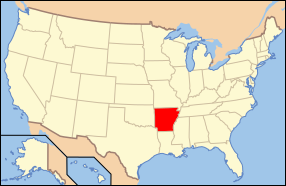Arkansas in the American Civil War
| State of Arkansas | |||||
|---|---|---|---|---|---|
| Nickname(s): None | |||||
|
|||||
| Capital |
Little Rock (1861–1863) Washington (1863–1864) |
||||
| Largest City | Little Rock | ||||
| Admission to confederacy | May 18, 1861 (9th) | ||||
| Population |
|
||||
| Forces supplied |
|
||||
| Major garrisons/armories |
Fort Smith Little Rock Arsenal |
||||
| Governor |
Henry Rector (1861–1862) Harris Flanagin (1862–1864) |
||||
| Lieutenant Governor | None | ||||
| Senators |
Robert Johnson (1862–1864) Charles Mitchel (1862–1864) Augustus Garland (1864) |
||||
| Representatives | List | ||||
| Restored to the Union | June 22, 1868 | ||||
Arkansas had initially voted to remain in the Union. But after Lincoln called for troops from every Union state to put down the rebellion after the capture of Fort Sumter, it seceded and then played a major role in controlling the Mississippi and neighbouring states.
Arkansas raised 48 infantry regiments for the Confederacy, mostly serving in the Western theatre, though the 3rd Arkansas served with distinction in the Army of Northern Virginia. Major General Patrick Cleburne was the state's most notable military leader. The state also raised some Union regiments, though these were mostly used for local anti-guerrilla patrols.
The Battle of Pea Ridge in March 1862 ensured Union control of Northern Arkansas, and Little Rock was captured in 1863. Programs such as the draft, high taxes, and martial law led to a decline in enthusiasm for the Confederate cause. The state was readmitted to the Union in 1868.
The slave state of Arkansas was a part of the Confederate States during the American Civil War, and provided a source of troops, supplies, and military and political leaders. Arkansas had become the 25th state of the United States, on June 15, 1836, entering as a slave state. Antebellum Arkansas was still a wilderness in most areas, rural and sparsely populated. As a result, it did not have early military significance when states began declaring secession from the Union. State Militia forces seized the Federal Arsenal in Little Rock before Arkansas actually voted to secede. The small Federal garrison was forced to evacuate after a demand by Arkansas Governor Rector that the arsenal be turned over to state authority. At the beginning of 1861, the population of Arkansas, like several states of the Upper South, was not keen to secede on average, but it was also opposed to Federal coercion of seceding states. This was shown by the results of state convention referendum in February 1861. The referendum passed, but the majority of the delegates elected were conditional unionist in sympathy, rather than outright secessionist. This changed after the Confederacy attacked Fort Sumter in South Carolina, and President Abraham Lincoln called for troops to put down the rebellion. The move toward open war shifted public opinion into the secessionist camp. Arkansas declared its secession from the Union on May 6, 1861, as the ninth of the eleven slave-states to join the Confederacy.
...
Wikipedia



